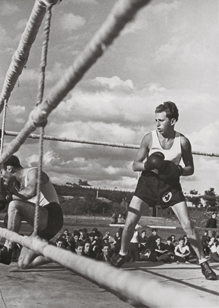
Maccabi club boxing tournament in the Grünewald square. Berlin, Germany, June 16th 1935. Photography: Herbert Sonnenfeld. Coll. Beth Hatfutsoth, Israël.
Book our events online
the invention
of a Jewish “new man”
“We must do away with the demeaning image of the stooping Jew in the ghetto, afraid for his life... Let us become strong men, with full chests and a deep, lucid expression in our eyes. More than any other, our people need programs of physical education. They will help strengthen our bodies and our character... We must ensure Jewish physical education clubs flourish and grow, setting an example in every Jewish community.”
With these words, Max Nordau began his muscular appeal to the assembly at the 1898 Second Zionist Congress, in Basle.
He then formulated the notion of Muscular Judaism, in reference to the “muscular Christianity” promoted by protestant headmasters of British public schools. However, there is a Jewish tradition of strength running down the ages, in disciplines as diverse as circus arts, weightlifting, wrestling and boxing, fencing and jujitsu.
Throughout the Middle Ages, and up until the interwar period, many Jewish artists were performing in German, Polish and Russian circuses: tightrope walkers, acrobats, contortionists and “fakirs”, frog and mouse-swallowers, fortune-tellers and magicians. It was through the circus that young Hungarian-American trapeze artist Erich Weiss (1874-1926) achieved worldwide fame under the moniker Houdini. Zishe Breitbart (1883-1925), who appeared on both sides of the Atlantic with Berlins Busch circus, belonged to another category: the “Strongest Man in the World”. This Warsaw Jew saw himself as another Samson, and dreamed of appearing in the British Mandate of Palestine. Next >>
quizz Who calls for a « muscular Judaism »? Zische Breitbart Max Nordau
